The last oddball at the Indianapolis Motor Speedway
Part 2: The road towards the 90P
Author
- Henri Greuter
Date
- December 11, 2008
Related articles
- March-Porsche 90P - The last oddball at the Indianapolis Motor Speedway, by Henri Greuter
- Introduction
- Part 1: About oddballs
- Part 3: The design
- Part 4: Performance evaluation (1)
- Part 5: Performance evaluation (2)
- Part 6: Final reflections
- Part 7: Specifications
- Part 8: Results
- Part 9: Insights about the 90P from one of its designers
- March-Alfa Romeo 90CA - Fiasco Italo-Brittanico, by Henri Greuter
- Porsche - Weissach's single Grand Prix win, by Mattijs Diepraam/Felix Muelas
Who?Teo Fabi What?March-Porsche 89P Where?Indianapolis When?1989 Indianapolis 500 (picture: Porsche press kit 1989) |
 |
Why?
With the introduction of ground effects in single-seater racing cars, it was unavoidable that the Indianapolis 500 would see cars built according that principal too.
In 1980, a large number of different cars and marques were still seen racing but 1981 saw the arrival of the March chassis: a customer car delivered on order to anyone 'off the shelf'. These 'buy-and-race' cars were quite competitive and March became one of the major car suppliers from then on. Lola joined the market in 1984 and between 1984 and 1987 anything other than a Lola or March was a rare bird (indeed, Eagles to be exact!) at CART events and at Indianapolis.
From 1987 on, March lost its edge over Lola, which became the dominant chassis supplier. Penske joined the fray again in 1988, and occasionally sold elderly cars to second-string teams. But the Chevy engine around which the Penskes were designed wasn't sold on. One exception was 1989 when the Patrick Racing Team had the opportunity to fight the Penske factory team on equal terms using the latest Penske type available. When their driver Emerson Fittipaldi became CART champion and won at Indianapolis beating the factory team he probably proved to Roger Penske once and for all to never sell any of his latest machinery to a top-line team.
The end of the oddball
In 1989 the chassis situation was like this: any non-Penske, non-Lola or non-March was non-existent. What made a car an oddball was its unconventional engine, so something other than a Cosworth DFX or DFS, Chevy Indy V8 or a Judd (Brabham-Honda) V8. Even then, the Buick V6-powered cars were modified versions of existing elderly cars. And even though the Porsche and Alfa Romeo-powered March cars of 1989 were different while the Porsche-powered 89P looked different too, they were designed according to a near standard basic design that had become the norm for the mid-engined single-seater CART racer with its single-turbo 2.65-litre V8.
The oddball, a car of a radically different design, had ceased to exist at the Indianapolis Motor Speedway. Well, almost.
Because for the 1990 CART season a car was built that, with hindsight, can be considered the last oddball ever to turn a wheel at the Indianapolis Motor Speedway, even if one cannot say the car in question was radically different from the others. Still, it was different and that's why we rate it as being an oddball. More ironically, this oddball was partly built by the company responsible for the end of the diversity in the then current generation of Indianapolis cars and CART machinery.
Prelude to an unusual machine
Extensive documentation about the earlier years of the late-eighties Porsche CART project has appeared in print already.4,5 In short, here are the major points.
During 1986 and 1987, Porsche developed their own CART racer, with its own V8 and chassis. The car, named Porsche 2708, debuted at the end of the 1987 CART season but the chassis in particular gained a reputation of being inadequate. There is, however, some evidence6 published that the 2708 chassis wasn’t as bad as is believed to be.
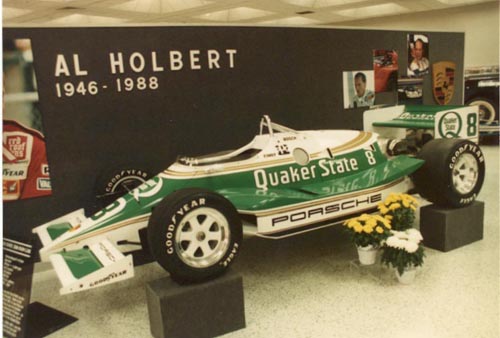
The disastrous 'on our own' Porsche 2708. Chassis 2708-003 - the last one built - was shown during May 1989 at the IMS Museum in a memorial tribute to Al Holbert. Holbert was the team principal in 1988 who died in an airplane crash late 1988. (photo HG)
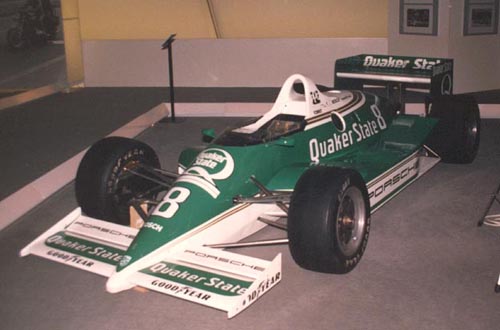
It appears there are differences between the several 2708 chassis made. Here is another one that was on display at the Dutch Autotron Museum at Rosmalen during the exposition “Porsche Totaal”, held in the summer of 1989. The rollhoop on this car is totally different to the one on display at the Indianapolis Motor Speedway Museum. The chassis plate on this car reads 2708-002. (photo HG)
Then, March 88C chassis were obtained for use with the German V8. Problem was that the V8 suffered from teething problems and the 88C was not the dominant car as the previous March designs had been. Mario Andretti had been the first candidate to drive the car but he backed off in time and Italian Teo Fabi became the Porsche driver. Fabi's best results in 1988 were 4th at Nazareth, 7th at Phoenix and Portland and 8th at Mid-Ohio and Elkhart Lake. He finished the 1988 CART season 10th.
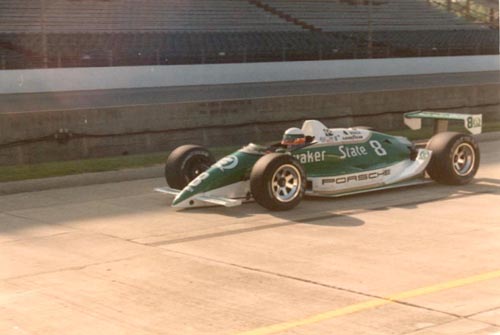
The March 88C-Porsche used in 1988. (photo HG)
The March factory ended its customer CART chassis program after 1988. Lola and Penske built better cars that year and the lone team that won CART races with March cars in 1988 (Galles Racing, with Unser Jr driving) used such an extensively updated machine that it wasn't much of a regular 88C anymore.
Instead, March opted for exclusive deals with both Porsche and Alfa Romeo to build each company its own, exclusive design: the 89P for Porsche and the 89CE for Alfa Romeo, both design teams working independently from each other.
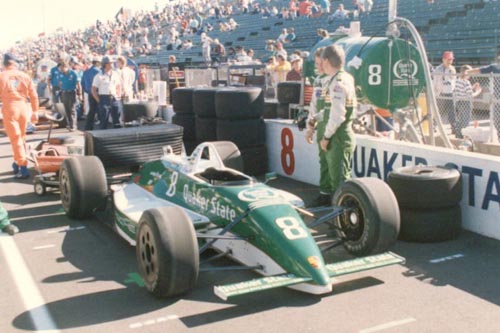
The March-Porsche 89P, less than two hours before the start of the 1989 500 miles race. (photo HG)
The Alfa-powered 89CA debuted at Detroit halfway during the season and shocked by finishing 8th on its debut race but that remained its only top-10 classification in the entire season.
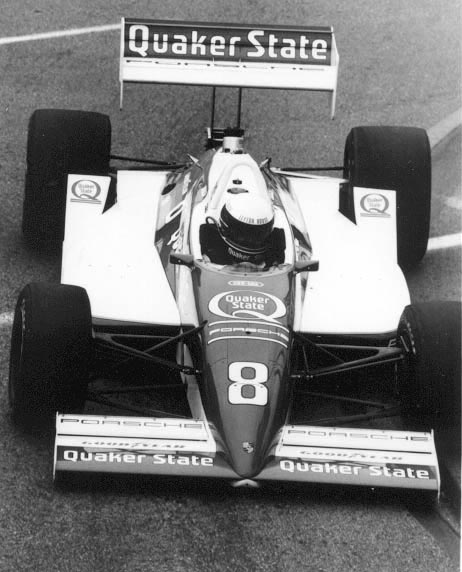
March 89P attacking a corner. (Porsche press kit 1989)
The Porsche-powered 89P, though not radically different from any other CART racer of that time, looked unusual courtesy of its nose. I have heard the nickname “ant-eater” being used for this particular car. After a cautious start the 89P came quite good, being victorious once at Mid-Ohio, finishing 2nd at Michigan and Elkhart Lake, taking a third at Milwaukee, and five 4th places and a 6th. The car also took two pole positions, Fabi finishing 4th in the season's final classification. Porsche was threatening to become a serious competitor.

One of the two 89P backups entered for 1990, here driven by Teo Fabi on Sunday, May 13, in one of the practice sessions before qualifying. (photo HG)
One thought remained about the ant-eater: given the doubts about whether the Porsche V8 was on par with the all-dominant Chevy V8 engine, if the 89P chassis had been developed for the Chevy engine, how good might such a Chevy-powered 89P have been?
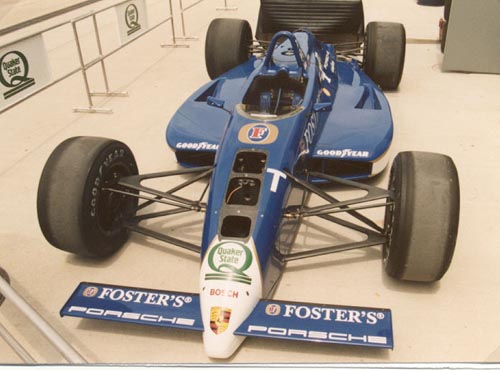
An 89P, the number us missing but this was likely the second car, the 4T, which never appeared on the track. (photo HG)
And with what would Porsche come up with for next season? Among the many answers for this question is the following: the last genuine oddball ever to run and race at the Indianapolis Motor Speedway.
1989 promocards
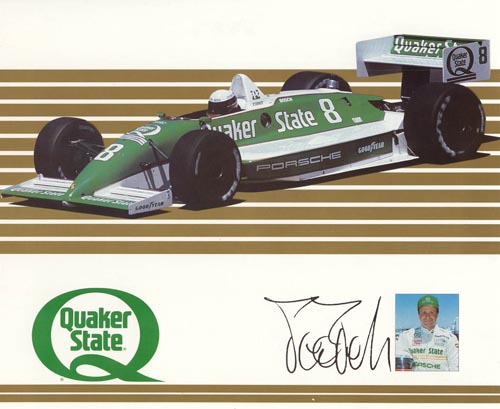
The Porsche Team promocard, as handed out at Indy during May 1989.
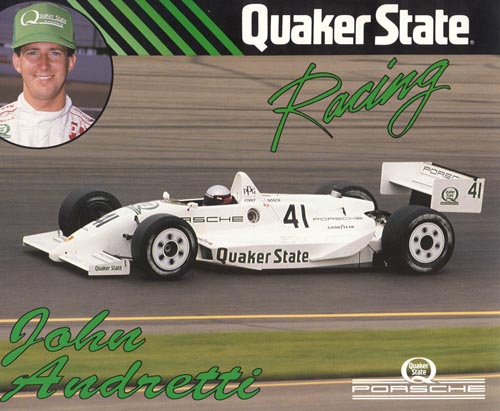
An early 1990 Team Porsche promocard, featuring the all-white 89P as raced in the first two races of the season. Look how deep John Andretti is sitting in the car! A similar card of Teo's car exists as well.
